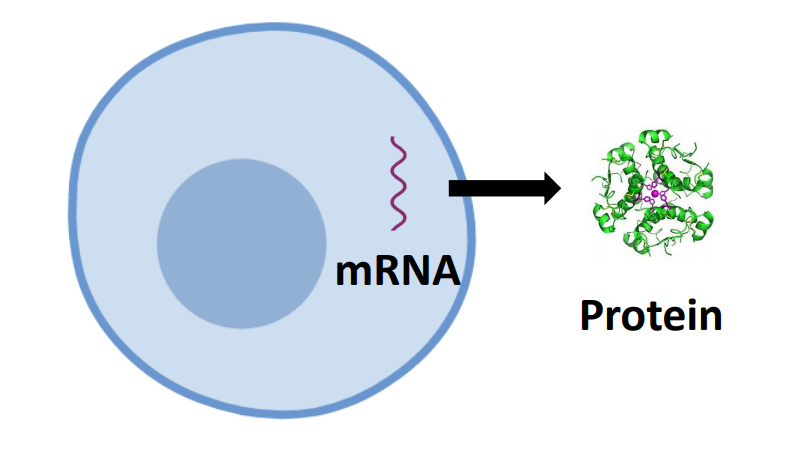Ph.D. Research Overview
Messenger RNA (mRNA) therapeutics have the potential to treat any disease with a genetic basis. This is because mRNA is the intermediate in the production of proteins, and disease states are often caused by a dysregulation of proteins. Therapeutic mRNA is very powerful as 1) there are natural pathways by which mRNA is degraded in the body, and 2) delivery of one mRNA can result in multiple copies of the protein of interest. Successful mRNA delivery can lead to therapeutic treatments like cancer immunotherapy, cellular reprogramming, protein replacement, and vaccination. The use of mRNA lipid nanoparticles gained much attention in 2020 as they were used by Moderna and Pfizer/BioNTech to create vaccines against COVID-19.
Mariah began her Ph.D. studies in August of 2018 in Dr. Whitehead’s Lab. She entered the lab with an NSF GRFP and started work on mRNA lipid nanoparticles. In 2022, Mariah received an NRSA NIH F31 from the National Institute on Aging to study the delivery of lipid nanoparticles.
Below is a summary of the skills and research Mariah has completed so far. Mariah is highly collaborative with her coworkers and has enjoyed the privilege of working on many projects. Some unpublished work is not detailed here but will be added as soon as it is available.
Synthesis of New Materials for Lipid Nanoparticles
mRNA Lipid nanoparticles are typically made of five components. The first is the lipidoid, which is a synthetic lipid that often dictates the lipid nanoparticle’s efficacy, biodistribution, and immunogenicity. At the start of her Ph.D. Mariah worked as one of the Whitehead Lab’s chemists. During the second year of her Ph.D., she became the lead chemist for the group, responsible for synthesizing new materials that lab members needed for their projects. Throughout her Ph.D. Mariah continued to gain knowledge in organic synthesis, purification, and chemical characterization techniques. Mariah synthesized over 50 new compounds and maintained the group’s large lipidoid library.
The other components of lipid nanoparticles are the helper lipids, which assist in the nanoparticle's structure and its ability to deliver its payload. Lipid nanoparticles also contain the small molecule cholesterol, which is added to the matrix. Lastly, there is the PEG (polyethylene glycol) lipid and the mRNA payload. The PEG-lipid assists in the circulation time and size of the nanoparticle.
Mariah has contributed to several ongoing Whitehead Lab papers with her chemistry skills. When completed, the papers will be listed below.
Efficacy and Specificity of mRNA Lipid Nanoparticle
Along with the synthesis of materials for mRNA delivery, Mariah works on screening and characterizing lipid nanoparticles. Mariah applies both in vitro (cell culture) and in vivo models to understand the delivery efficacy and specificity of mRNA lipid nanoparticles. The delivery efficacy of mRNA lipid nanoparticles is typically assessed by measuring the production of a protein after mRNA delivery. It is widely accepted that higher protein production equates to superior mRNA delivery. The specificity of mRNA lipid nanoparticles relates to which organs and cell populations the mRNA is delivered to. Each lipidoid and helper lipid combination will dictate a specific efficacy and specificity. Understanding the impact of formulations can assist in the creation of new therapeutic treatments.
Mariah has contributed to publications on replacing common helper lipids (DOPE) to alter organ specificity and deliver to reticuloendothelial organs (liver, spleen, and lungs). In addition, she has assisted in investigating how mRNA base modifications and lipid nanoparticle chemistry alter mRNA delivery outcomes. More recent work has explored delivery to non-reticuloendothelial cells with delivery to the pancreas.
Publications
Drug Delivery for Pregnant People
Many physiological changes occur during pregnancy that impact drug delivery outcomes for the pregnant person and fetus. This is true for both small molecules and nanotherapeutics. Mariah has assisted in research investigating lipid nanoparticle delivery during pregnancy.
A publication from the Whitehead Lab demonstrated that lipid nanoparticles do not cross the placental barrier, and non-immunogenic lipid nanoparticles do not affect pup health. Another paper Mariah worked on investigated different sizes and shapes of molecules to understand the limits of the placental barrier.
Publications
Collaboration Research
Mariah has had the privilege of engaging in collaborative research during her Ph.D. studies. Her longest collaboration has been with Markita Landry's group at U.C. Berkeley, where they investigated and characterized the protein corona on mRNA Lipid nanoparticles. Mariah has also worked with Dr. Jake Brenner at the University of Pennsylvania and Dr. Siyang Zheng at Carnegie Mellon University.



